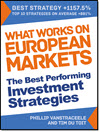If you want a simple way to increase your stock returns and lower risk, this article gives you the answer. You will learn how a 9-point checklist called the Piotroski F-score helped investors beat the market for 21 years - through crashes and pandemics. And it also works with large, well-known stocks in Europe.
This post shows you how to apply the same strategy in your own portfolio, step-by-step. No hype. No guesswork. Just data and results. If you want clarity and control over your investing, you will want to read this.
Estimated Reading Time: 6 minutes
Can Simple Accounting Rules Still Beat the Market? A 21-Year Study Says Yes
A Simple Question with a Surprising Answer
Do you want a way to increase your stock returns without getting caught in hype or relying on guesswork. That is exactly what a group of researchers tested in their research paper The relevance of using accounting fundamentals in the Euronext 100 index using real data from European markets.
Their focus: can one simple indicator, the Piotroski F-score, help you pick better stocks?
The answer was yes.
And not just in small or unknown companies as it was developed for. This test was run on the Euronext 100 Europe’s 100, Euronext N.V.’s large company index. It covers around 80% of the largest companies on the exchange and contains companies from a variety of European countries, as well as the largest and most liquid stocks trading on four different stock exchanges: Amsterdam, Brussels, Lisbon and Paris.
And the F-score still worked.
In this article, you will learn what the F-score is, how it was tested, and how you can use it in your own portfolio.
What Was Tested (and Why It Matters to You)
The study tested a checklist called the Piotroski F-score. It has 9 simple tests, all based on financial statement data. Each “yes” earns 1 point. Each “no” earns 0. Companies score from 0 (worst) to 9 (best).
The 9 F-score checks are:
-
ROA > 0: Is the company profitable?
-
Change in ROA > 0: Is profitability improving?
-
Operating Cash Flow > 0: Is the business generating real cash?
-
OCF > Net Income: Are profits backed by cash flow?
-
Decline in Leverage: Is long-term debt going down?
-
Improved Current Ratio: Is short-term financial strength improving?
-
No New Shares Issued: Has the company avoided dilution?
-
Gross Margin Improvement: Are margins getting stronger?
-
Improved Asset Turnover: Is the company using its assets more efficiently?
Why should you care? Because if a stock scores 8 or 9, it is financially strong and improving. That gives you a huge edge finding better quality companies when you are investing your own money.
Market Scope and Sample Selection
The study backtested Euronext 100 companies over the 21 years from 2000 to 2020.
This is not a cherry-picked period. It includes the dot-com crash, the 2008 global crisis, the European debt crisis, and the COVID pandemic. So, the F-score was tested in all types of markets.
Avoiding Bias: How Robust Was the Method?
The researchers made sure the test was realistic:
-
No look-ahead bias: Only past data, 3-month delay after year-end was used to score companies.
-
Portfolios were formed after annual reports were published in April each year and sold at the end of March the following year.
-
Controlled for other factors: Size, book-to-market (a value ratio), and earnings per share were included in the models.
This is important. They asked: Does the F-score still help, even when you account for cheap valuations or company size?
The answer was yes.
Click here to start finding High F-Score companies NOW!
Does The F-Score Really Increase Returns?
To test if the F-score is strongly linked with future returns, the study tested what would happen if you used the F-score to build a simple investment strategy.
They sorted all the companies into nine groups, based on its F-Score. Then they measured the return of each group over one year and two years.
They did this every year from 2000 to 2020.
To keep things realistic, they formed the portfolios each April (after companies published their annual results) and held the stocks for 12 months or 24 months.
Every stock in each group was given an equal weight.
This is what they found:
Source: The relevance of using accounting fundamentals in the Euronext 100 index.
Notes: Mean R = The geometric mean return. For the two-year period annualised
mean returns were calculated. ER = excess return over the market.
The Higher the F-Score the Higher Your Return
What they found was clear: the higher the F-score, the higher the returns.
On average, companies with top F-score of 8 or 9 earned about +16.4% per year, which was about +25.7% more than companies with low scores (1 and 2).
If you look at returns above the market, the best F-score group beat the market by +11.3% in one year and 6.7% over two years. And this is on average over 21 years!
This shows that the F-score works best when you check it each year and refresh your portfolio. After a year, the company’s situation can change, so it is better not to hold the same stocks for too long without checking the F Score.
So, your main takeaway: using the F-score can help you find higher performing stocks if you update it at least once a year.
Real-World Takeaways for Your Portfolio
Here is how you can start using the F-score:
-
Score the company from 0 to 9 using the 9 F-score rules. Some screeners like Quant Investing does this for you.
-
Only buy the top scorers (8 or 9). These are financially healthy and improving companies.
-
Rebalance your portfolio once a year. You do not need to trade monthly.
-
Avoid low scores (1 or 2). These stocks tend to underperform or lose money.
-
Use F-score with value metrics like PE or Price-to-Book. It works even better when combined.
Final Thought: This Is the Edge You Need
Many investors look at value ratios. Some look at financial health. The F-score gives you a clear picture of a company’s health and if it is improving.
The best part? It is simple. You can easily add it to your existing strategy and it increases your odds of success. That is what the research shows, over 21 years, across market crashes and recoveries.
If you want to invest smarter without adding stress, the F-score is one of the most powerful tools you can use.
Add it to your investment strategy now.
Click here to start finding High F-Score companies NOW!
FREQUENTLY ASKED QUESTIONS
1. How do I know if a stock has a good F-score without doing all the calculations myself?
You can use a screener like Quant Investing, which automatically scores thousands of stocks using the 9-point Piotroski F-score. Just set the filter to only show companies with a score of 8 or 9. This saves hours and gives you a clear list of financially strong stocks in seconds.
2. I already use PE and Price-to-Book. Why add the F-score?
Those ratios tell you if a stock is cheap. But they do not show if the business is healthy. The F-score adds a second lens: it confirms whether a company’s profits, margins, and debt are improving. Using both together helps you avoid “value traps” - cheap stocks with worsening fundamentals .
3. Do I need to check the F-score every month?
No. The study shows rebalancing once a year is enough. Check the F-score each April when companies release annual reports. The Quant Investing stock screener updates the F Score each time results are published so it is always up to date. Refresh your portfolio then. This keeps your investing low-effort and backed by strong data.
4. What if a stock’s score drops during the year? Should I sell?
It depends on your system. But the research suggests holding for a full year works well, even through ups and downs. Selling too soon might cut off gains. Set a rule (like an annual review) and stick to it for better long-term results. You can of course also use a strict system to keep losses low.
5. Does the F-score work in U.S. or Asian markets too?
Yes. The F-score was originally tested in the U.S. and has since been validated globally. It has worked in small-cap stocks, large-cap indexes like the Euronext 100, and across multiple market crises. It is a robust, universal tool.
6. I made bad picks before. Can using the F-score really help me do better?
Yes. That is exactly what it is for. The F-score removes guesswork and focuses you on improving companies. It helped investors in the study earn +11.3% more than the market. It gives you a system to follow, even if you have made mistakes in the past.
7. What is the biggest mistake I can make using the F-score?
Buying low-scoring stocks (F-score 1 or 2) just because they look cheap. These are often the worst performers. The research is clear: low F-score = lower returns and higher risk. Stick to 8s and 9s for the best odds of success.
Click here to start finding High F-Score companies NOW!
Source: Navas, R. D., Gama, A. P. M., & Bentes, S. R. (2023). The relevance of using accounting fundamentals in the Euronext 100 index. Revista Brasileira de Gestão de Negócios, 25(4), p.456-479. https://doi.org/10.7819/rbgn.v25i4.4245)


